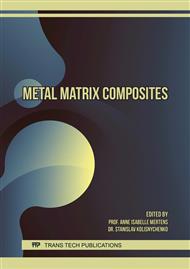[1]
D.D. Gu, Laser additive manufacturing of high-performance materials, Springer, Berlin, Heidelberg, (2015).
Google Scholar
[2]
K. Yihong, S.B. Tor, N.H. Loh, Comparison of two metallic additive manufacturing technologies: Selective laser melting and electron beam melting, in: Proc. Int. Conf. Prog. Addit. Manuf., 2014: p.231–239.
DOI: 10.3850/978-981-09-0446-3_033
Google Scholar
[3]
P.A. Lykov, R.M. Baitimerov, S.D. Vaulin, Influence of SLM Process Parameters on Porosity of Nickel Base Heat Resistance Alloy EP648, Mater. Sci. Forum. 843 (2016) 253–258.
DOI: 10.4028/www.scientific.net/msf.843.253
Google Scholar
[4]
X. Shi, S. Ma, C. Liu, C. Chen, Q. Wu, X. Chen, J. Lu, Performance of high layer thickness in selective laser melting of Ti6Al4V, Materials (Basel). 9 (2016).
DOI: 10.3390/ma9120975
Google Scholar
[5]
A.H. Maamoun, Y.F. Xue, M.A. Elbestawi, S.C. Veldhuis, Effect of selective laser melting process parameters on the quality of al alloy parts: Powder characterization, density, surface roughness, and dimensional accuracy, Materials (Basel). 11 (2018).
DOI: 10.3390/ma11122343
Google Scholar
[6]
P. Szymczyk, G. Ziółkowski, A. Junka, E. Chlebus, Application of Ti6Al7Nb alloy for the manufacture of biomechanical functional structures (BFS) for custom-made bone implants, Materials (Basel). 11 (2018).
DOI: 10.3390/ma11060971
Google Scholar
[7]
X. Han, T. Sawada, C. Schille, E. Schweizer, L. Scheideler, J. Geis-Gerstorfer, F. Rupp, S. Spintzyk, Comparative analysis of mechanical properties and metal-ceramic bond strength of Co-Cr dental alloy fabricated by different manufacturing processes, Materials (Basel). 11 (2018).
DOI: 10.3390/ma11101801
Google Scholar
[8]
B. Ealy, L. Calderon, W. Wang, J. Kapat, I. Mingareev, M. Richardson, R. Valentin, Characterization of lam-fabricated porous superalloys for turbine components, in: Proc. ASME Turbo Expo, (2016).
DOI: 10.1115/gt2016-58080
Google Scholar
[9]
L. Denti, Additive manufactured A357.0 samples using the laser powder bed fusion technique: Shear and tensile performance, Metals (Basel). 8 (2018).
DOI: 10.3390/met8090670
Google Scholar
[10]
D. Gu, Y. Shen, L. Zhao, J. Xiao, P. Wu, Y. Zhu, Effect of rare earth oxide addition on microstructures of ultra-fine WC-Co particulate reinforced Cu matrix composites prepared by direct laser sintering, Mater. Sci. Eng. A. 445–446 (2007) 316–322.
DOI: 10.1016/j.msea.2006.09.057
Google Scholar
[11]
P.A. Lykov, S.B. Sapozhnikov, R.M. Baitimerov, The manufacturing of the AlSi12-Al2O3 composite powder for additive production methods, Solid State Phenom. 870 (2016) 314–317.
DOI: 10.4028/www.scientific.net/msf.870.314
Google Scholar
[12]
J. Li, Z. Zhao, P. Bai, H. Qu, M. Liang, H. Liao, L. Wu, P. Huo, Tribological behavior of TiC particles reinforced 316Lss composite fabricated using selective laser melting, Materials (Basel). 16 (2019).
DOI: 10.3390/ma12060950
Google Scholar
[13]
P.A. Lykov, S.B. Sapozhnikov, I.S. Shulev, D.A. Zherebtsov, R.R. Abdrakhimov, Composite Micropowders for Selective Laser Sintering, Metallurgist. 59 (2016) 851–855.
DOI: 10.1007/s11015-016-0183-0
Google Scholar
[14]
R. Thiraviam, T. Sornakumar, A.S. Kumar, Development of copper: Alumina Metal Matrix Composite by Powder Metallurgy method, Int. J. Mater. Prod. Technol. 31 (2008) 305–313.
DOI: 10.1504/ijmpt.2008.018029
Google Scholar
[15]
ASTM B212-13, (2013).
Google Scholar
[16]
ASTM B417-13, (2013).
Google Scholar
[17]
A.B. Spierings, M. Schneider, R. Eggenberger, Comparison of density measurement techniques for additive manufactured metallic parts, Rapid Prototyp. J. 17 (2011) 380–386.
DOI: 10.1108/13552541111156504
Google Scholar
[18]
P.A. Lykov, E. V Safonov, A.O. Shul'ts, Powder particle formation mechanism with dispersion of different molten metals, Metallurgist. 57 (2013) 232–236.
DOI: 10.1007/s11015-013-9717-x
Google Scholar
[19]
J.B. Jones, D.I. Wimpenny, R. Chudasama, G.J. Gibbons, Printed circuit boards by selective deposition and processing, in: 22nd Annu. Int. Solid Free. Fabr. Symp. - An Addit. Manuf. Conf. SFF 2011, 2011: p.639–656. https://www.scopus.com/inward/record.uri?eid=2-s2.0-84875456265&partnerID=40&md5=50e904a2708c7b3a1f46dc36859a2b4a.
Google Scholar
[20]
M.A. Lodes, R. Guschlbauer, C. Körner, Process development for the manufacturing of 99.94% pure copper via selective electron beam melting, Mater. Lett. 143 (2015) 298–301.
DOI: 10.1016/j.matlet.2014.12.105
Google Scholar
[21]
A. Popovich, V. Sufiiarov, I. Polozov, E. Borisov, D. Masaylo, A. Orlov, Microstructure and mechanical properties of additive manufactured copper alloy, Mater. Lett. 179 (2016) 38–41.
DOI: 10.1016/j.matlet.2016.05.064
Google Scholar
[22]
D.Q. Zhang, Z.H. Liu, C.K. Chua, Investigation on forming process of copper alloys via Selective Laser Melting, in: High Value Manuf. Adv. Res. Virtual Rapid Prototyp. - Proc. 6th Int. Conf. Adv. Res. Rapid Prototyping, VR@P 2013, 2014: p.285–289. https://www.scopus.com/inward/record.uri?eid=2-s2.0-84892183336&partnerID=40&md5=e5cd0cc7866eae0729a69c43755731ce.
DOI: 10.1201/b15961-53
Google Scholar
[23]
P. Lykov, R. Baytimerov, S. Vaulin, E. Safonov, D. Zherebtsov, Selective Laser Melting of Copper by 200 W CO2 Laser, SAE Tech. Pap. 2016-April (2016).
DOI: 10.4271/2016-01-0333
Google Scholar
[24]
S.D. Jadhav, S. Dadbakhsh, L. Goossens, J.-P. Kruth, J. Van Humbeeck, K. Vanmeensel, Influence of selective laser melting process parameters on texture evolution in pure copper, J. Mater. Process. Technol. 270 (2019) 47–58.
DOI: 10.1016/j.jmatprotec.2019.02.022
Google Scholar
[25]
N.K. Tolochko, T. Laoui, Y. V Khlopkov, S.E. Mozzharov, V.I. Titov, M.B. Ignatiev, Absorptance of powder materials suitable for laser sintering, Rapid Prototyp. J. 6 (2000) 155–160.
DOI: 10.1108/13552540010337029
Google Scholar



